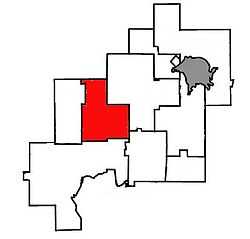Rayside-Balfour
| Rayside-Balfour | |
|---|---|
| Community | |
|
| |
 Location of Rayside-Balfour within Greater Sudbury. | |
| Country | Canada |
| Province | Ontario |
| City | Greater Sudbury |
| Ward | 3, 4 |
| Incorporated | January 1, 1973 |
| Dissolved | December 31, 2000 |
| Government | |
| • City Councillor | Gerry Montpellier, Evelyn Dutrisac |
| • Governing Body | Greater Sudbury City Council |
| • MPs | Claude Gravelle (NDP) |
| • MPPs | France Gélinas (NDP) |
| Population (2011)Statistics Canada | |
| • Total | 14,557 |
| Population computed by combining Census Tracts 5800160.00, 5800161.01, 5800161.02 and 5800162.00 | |
| Time zone | EST (UTC-5) |
| • Summer (DST) | EDT (UTC-4) |
| Postal Code FSA | P0M |
| Area code(s) | 705 |
| Website | Rayside-Balfour Community Action Network |
Rayside-Balfour (1996 census population 16,050) was a town in Ontario, Canada, which existed from 1973 to 2000.
It was created as part of the Regional Municipality of Sudbury. The town took its name from the townships of Rayside and Balfour, which fell within the boundaries of the new town; prior to the town's creation in 1973, Rayside and Balfour were separately incorporated as township municipalities.[1]
Although the Regional Municipality of Sudbury was a very important centre of Franco-Ontarian population and culture, Rayside-Balfour was the only town in the regional municipality which had a majority francophone population.
On January 1, 2001, the town and the Regional Municipality were dissolved and amalgamated into the city of Greater Sudbury. The Rayside-Balfour area is now divided between Wards 3 and 4 on Greater Sudbury City Council, and is represented by councillors Gerry Montpellier and Evelyn Dutrisac.
In 2006, there was interest in the deamalgamation of the former town of Rayside-Balfour from the City of Greater Sudbury. However, as any referendum on the matter would require the consent of the provincial government, any such move is not likely to take place.
In the Canada 2011 Census, the entire main populated core of Rayside-Balfour was counted as part of the population centre (or urban area) of Sudbury, with no separate population statistics published for the Rayside-Balfour area alone.[2]
Communities
Azilda
Azilda gets its name from Azilda Bélanger (née Brisebois), the first female pioneer of the area and wife of Joseph Bélanger. The community borders the eastern shore of Whitewater Lake.
Municipal Road 35, linking Azilda to downtown Sudbury, has been increased from two lanes to four lanes, which improved the commute for Azilda's workers, who are mostly employed in the city's urban core. In addition, it shortens the travel time for tourists hoping to visit Sudbury Downs, which is located in the outskirts of Azilda. There are future plans to complete the widening of Municipal Road 35 between Azilda and Chelmsford, although the start of the construction has not yet been determined.
On September 12, 1906, Azilda was the site of a train wreck.
Azilda's telephone and postal service also includes the smaller local neighbourhoods of Bélanger and Simard.
Chelmsford
Founded in 1868, Chelmsford started out as an outpost on the Canadian Pacific Railway. Some say Chelmsford was named by one the Canadian Pacific Railway engineers, who was from the United Kingdom. As with many communities in Northern Ontario, logging and fur trapping were the first industries. Having depleted the lumber in the early 1900s, Chelmsford turned to mining and agriculture to support the town's economy. Errington Mine and Nickel Offset mine were two of the largest mines in Chelmsford and both closed in the 1930s.
In 1909, Chelmsford was separately incorporated as a town. It retained this status until 1968, when it was reamalgamated with the township of Balfour.[1]
Today, Chelmsford has no major industries and is mostly a residential community. Although there are still some farms producing mostly potatoes, small fruits and corn, it is mostly supported by the mining activities in the nearby communities of Onaping Falls and Copper Cliff.
Postal delivery and telephone service in Chelmsford also includes the smaller neighbourhoods of Boninville, Hull and Larchwood.
Chelmsford is host to an annual fiddle festival, Fiddle Works, in May.
Education
There are two francophone schools (École publique Franco-Nord and École catholique Ste-Marie) in Azilda. All anglophone students must attend a school in Chelmsford.
Chelmsford is home to an English language secondary school: Chelmsford Valley District Composite School, which offers French immersion and English high school, specializing in technology and the trades with an excellent STAR (Science and Tech Achieving Results) academic programme. CVDCS' motto is "The Place to Be". École secondaire catholique Champlain is the francophone high school in the area, which serves the former towns of Rayside-Balfour and Onaping Falls.
Chelmsford is also home to a new elementary school, École Alliance St-Joseph. The school, part of the Conseil scolaire de district catholique du Nouvel-Ontario, services the francophone community and is the largest population-wise in the entire City of Greater Sudbury, amalgamated three separate French Catholic elementary schools: St-Joseph, Jacques-Cartier and Monseigneur-Côté. The school uses advanced technology in the classroom, and provides its students with portable computers for in-class use.
The community is also home to a French public school, Pavillon-de-l'Avenir, which is housed in the former Collège Rayside-Balfour section of the Chelmsford Valley District Composite School building.
Notable people
- Robert Campeau, financier
- Randy Carlyle, NHL hockey player
- Chuck Labelle, musician
- Stéphane Paquette, musician and actor
References
External links
- www.azilda.ca - Azilda Community Action Network
- Hello Chelmsford - Chelmsford Community Action Network
| ||||||